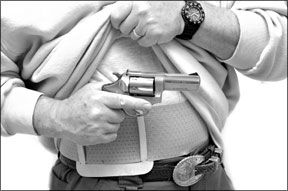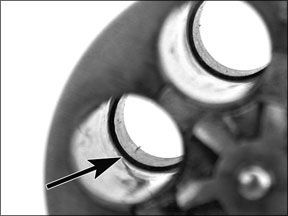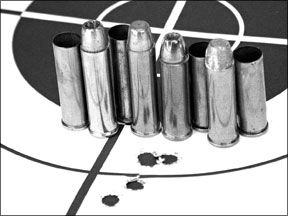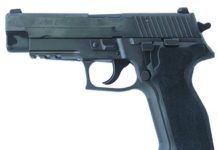Reader mail tells us that Gun Tests readers are still interested in smaller-caliber handguns, and a new trend in wheelguns may be on the horizon. In our August 1999 test of .32 H&R Magnum revolvers, we learned that six rounds of thirty-two can be machined nicely into the same small cylinder that typically houses five rounds of .38 Special. We also saw that modern defense loads such as frangible ammunition can produce a lot of damage without harsh recoil. In this evaluation, we will examine a pair of .32 H&R Magnum revolvers and a third gun that may jump-start fresh interest in the snubnosed revolver.

Because so few handguns are chambered for the .32 rounds, we had to mix single-action and double-action products, or else never test the category. Our first revolver is a single-action Western-style replica from Heritage Manufacturing. The No. SRR32MBS3BH Rough Rider is a 3.6-inch-barreled six-shot revolver with a birds head grip frame. It has a manual safety, but otherwise fits the profile of a period piece. The other two revolvers are both Ruger SP101s, and they are nearly identical. Our SP101 SP-3231X was chambered for .32 H&R Magnum. However, the six chambers of our SP101 KSP-32731X provides about one-eighth inch of additional space to accommodate .327 Federal Magnum ammunition. This is a new cartridge developed by Federal and Ruger that seats a 0.312-inch diameter bullet atop a taller, stronger case that we measured to be just less than 1.2 inches long.
Accuracy tests were performed from a sandbag rest from a distance of 15 yards. Two different loads in each caliber were fired single action only. Our .32 H&R Magnum ammunition was Federal Champion 95-grain lead semi-wadcutters and Federal Personal Defense 85-grain jacketed hollowpoints. We had difficulty locating any .327 Magnum ammunition. Fortunately, we were able to locate American Eagle 100-grain jacketed soft points and Federal Premium 85-grain Hydra-Shok JHP rounds at Tomball Pawn in Tomball, Texas, (tomballpawn.com). Retail price was $23.95 for a box of 50 rounds of the American Eagle and $18.95 for the Hydra-Shok ammunition. The Hydra-Shok was packaged in plastic 20-round display boxes. The Hydra-Shok packaging looked great, but as usual we found each box difficult to open.
We wanted to know if the creation of a new cartridge was worth the trouble. Was it more accurate? Did it offer a desirable increase in power yet still avoid the loud noise and harsh recoil of .357 Magnum ammunition. Was the .32 H&R Magnum still viable, or would the .327 Magnum make it obsolete?
Ruger SP101 KSP-32731X
.327 Magnum, $572
We have to admit that we were fooled by Rugers packaging. Both SP101s arrived in the familiar gray plastic case, but the box containing the .327 Magnum revolver was longer than its H&R counterpart. But we soon realized that our two guns were the same size and visually identical. Each gun was satin stainless from end to end. Ruger lists the barrels as being 3 1/16 inches long. All SP101s utilize the same rubber grip secured by a screw, that despite being naked on both ends did not interfere with our hands. The ejector rod, which plays no part in lockup, was shielded by the full-length underlug. The cylinder release was operated by a pivoting action, and there was a second detent where the crane disappeared into the frame.

A ramp-style front sight, black in color and lined to reduce glare, was pinned into place. The top strap was flat and broad. The rear sight blade was thin, featuring a white outlined notch, and it rode in a channel cut into the top of the frame. Directly below the cut on the right side was a small screw for adjusting windage. The screw required a small flat-blade screwdriver, such as those found in an eyeglass repair kit. Clockwise movement pushed our hits left. Counter-clockwise movement pulled shots to the right, and once we ran out of adjustment the screw began exiting the frame. The adjustability came in very handy, and we thought the sight picture was a big improvement over a notched top strap. The tradeoff between a notched top strap and a blade is that of durability. But the blade found here looked substantial.
The .327 Magnum revolver offered the versatility of being able to fire .32 H&R Magnum ammunition in much the same way a .357 Magnum revolver will also shoot .38 Special. But one problem with loading .38 Special into a .357 Magnum length cylinder is the buildup of debris where the shorter case ends inside the chambers. Once you find it necessary to force the Magnum ammunition into the individual chambers, the danger of increased pressure has reached a critical level. In the case of the .327 Magnum revolver, this characteristic was magnified. We didnt try H&R rounds or for that matter .32 S&W ammunition in the .327 because we found that the narrow chambers of the .327 Magnum revolver had little tolerance for debris. After just 20 rounds of 100-grain JSP ammunition, one chamber was fouling badly, forcing us to jam the fresh rounds into place. We should note that in comparison, the 85-grain Hydra-Shok rounds left significantly less debris. Overall, we noticed that keeping the barrel and chambers of the .327 model clean made a bigger difference in terms of accuracy and operation than it did in our .32 H&R Magnum SP101 revolver.
Firing through the Oehler chronograph, we learned that the 85-grain and 100-grain slugs were zooming along at an average velocity of 1422 fps and 1410 fps respectively. Based on these figures, the heavier American Eagle rounds were generating more muzzle energy than the faster moving 85-grain ammunition. The resulting 442ft .-lbs of muzzle energy was very close to the 459 ft.lbs produced by the 3-inch-barreled Smith & Wesson 386SC we tested in our March 2002 issue when firing 125-grain JHP .357 Magnum ammunition. But the difference in the amount of noise and recoil was remarkable. Each shot of .327 Magnum was just loud enough to prompt extra hearing protection. In comparison the report of the 125-grain .357 Magnum ammunition seemed volcanic. Also, no one asked for a shooting glove to complete the tests of our .327s.
Firing single action only, we found that the trigger had just enough takeup to be helpful. The 85-grain .327 Magnum Hydra-Shok ammunition grouped consistently into a circle averaging just less than 2 inches across. The 100-grain American Eagle JSP rounds were more accurate if you controlled the recoil. One characteristic of this combination of gun and caliber we observed was that the ammunition topped with the heavier bullet produced substantially more felt recoil. When we did our job and controlled the gun, we were rewarded with groups as small as 0.9 inches across. If we failed to follow through and muzzle flip was allowed to take charge, our groups opened up. We would like to try the .327 Magnum in a rifle. We think that the added control of shouldering the weapon could make for a real tackdriving duo of long gun and sidearm.
Firing the .327 Magnum version of the SP101, we noticed that the double-action trigger pull was heavier than on the .32 H&R revolver. Just as the walls of the .327 cases were heavier to withstand the higher pressure, we think that the primer on the .327 ammunition may also be capped with a heavier-gauge metal to avoid primer flow or blowout. This would necessitate a stronger hammer strike, which would account for the heavier trigger. However, we were unable to verify this with Ruger or Federal Cartridge. Nevertheless, the double-action pull was efficient and clean.
The new .327 Magnum cartridge offers nearly the same power as .357 Magnum ammunition. The advantage of this new round is lower noise and less recoil. Its potential has not gone unnoticed among the varmint-hunting crowd, especially those looking to stop the advancement of predators that are beginning to invade the suburban landscape. One of our staffers mentioned that the SP101 .327 Magnum could be the perfect trap line gun. Another said they wanted an eight-shot model based on a medium-sized frame like Rugers GP100. For now, the SP101 .327 Magnum is a very good gun that represents considerable potential.
Ruger SP101 KSP-3231X
.32 H&R Magnum, $572
In terms of construction, everything we had to say about the .327 Magnum model holds true for the .32 H&R Magnum SP101. However, this gun was more forgiving in terms of shooting alternate ammunition such a .32 S&W. The lower pressure helped make it less sensitive to debris building up in the chambers. Firing the H&R Magnum ammunition, we were reminded why this caliber is still hanging on. The recoil was pleasant, and accuracy did not depend largely on recoil control, a characteristic common to snubnosed revolvers of more powerful calibers. Velocity of our more powerful rounds, the 85-grain JHPs, was closer to 1100 fps and produced about 211 ft.-lbs. of energy.
In our August 1999 test of .32 H&R Magnum snubbies, the SP101 KSP-3231 produced more than 290 ft.-lbs. of muzzle energy firing 50-grain MagSafe Defender ammunition. This is one of the top-selling frangible rounds. The low bullet weight helped contribute to less muzzle flip. For those with less hand strength or a touch of arthritis, or even shooters with less time to practice, the appeal of .32 H&R Magnum is obvious. A 4-inch-barreled SP101 chambered for .32 H&R Magnum was recently discontinued. We would have liked to know how much added velocity and punch was available from the 4-inch barrel.

As noted, the double-action trigger on our .32 H&R revolver was lighter than the one found on the .327. The difference was only 2 pounds but it seemed like more. The 12-pound DA trigger found on the .32 H&R is generally accepted as the ceiling. We think 14-pound DA triggers are excessive. We found it much easier to replicate rapid fire strings dry-firing the .32 H&R model and then perform such drills live.
From the bench we were happy to find that the hollowpoint ammunition was not only stronger but more accurate. We didnt have any trouble at all printing 1-inch-wide groups. Our average for five five-shot groups was a measurement of 1.2 inches across at a distance of 15 yards, and we think this figure is wholly representative. We found this gun to be a pleasure to shoot, and only wish a wider variety of .32 Magnum ammunition was available.
Heritage Manufacturing
Rough Rider SRR32MBS3BH
.32 H&R Magnum, $230
If you are wondering why we are comparing a single-action cowboy gun to a pair of modern double-action revolvers, the reason is lack of available choices. The .32-caliber revolvers are scarce, and besides that we are suckers for small revolvers with a birds head grip frames. There was no denying that the Rough Rider with the BH suffix is a charming little gun. We found it easy to conjure up visions of walking the streets of Tombstone with one of these guns tucked inside a silk vest.
The owners manual says the Rough Rider is “a classic 4 click Single Action Revolver,” but it is nonetheless unique. The first click was the old Colt “safety notch.” The need for this position was superseded by the mechanical safety lever located at the upper left radius of the frame that backs the cylinder. Lever up was the safe-on position. The hammer can be pulled back and even dropped with the safety on, but the gun will not fire. Pulling back on the safety lever exposed a red dot, telling the shooter the safety is off. The second click heard from pulling back the hammer was the loading notch. Loading and unloading was performed by opening the loading gate at the lower right side radius of the frame. The ejector rod, limited by the short barrel was long enough present the empty case but we were seldom able to drive the case from the gun hard enough to let it fall free. The third click was of no consequence. The fourth and final click signified the hammer was cocked.
Unfortunately, our Rough Rider did not live up to the standard set by our previous tests of Heritage products, (most notably the Rough Rider .45 LC, which we rated among the best guns of 2006). The point of impact produced by the .32 model was about 12 inches above point of aim. Utilizing a Caldwell Pistol Target of typical notebook size, this meant we had to aim below the target to get even a portion of each group on paper. Furthermore, we experienced at least one low flier per six shots. We suspect it was the result of one specific chamber producing as much as 78 fps less velocity than the others when firing the 95-grain lead semi-wadcutter ammunition. Keyholing was evidenced by tears in the paper target leaving a jagged hole. Somehow we were able to land one respectable group measuring 3.5 inches across. But other groups were in the 5- to 6-inch range when we avoided loading the lowest-pressure-producing chamber. The 85-grain JHP ammunition was better, but the sights were still completely unsuitable. Toward the end of the session, we noticed that the tip of the ejector rod was marred with a jagged edge, making operation uncomfortable. We dont know why we hadnt noticed it earlier. Perhaps it had been covered over by filler that fell away during our test session. The loading gate needed more detent in the open position. The slightest touch would cause it to flip closed just when we needed it to remain open.
We cannot fault the trigger mechanism for the lack of accuracy. The trigger was smooth and consistent. The problem concerning point of impact was clearly the result of mismatched sights. Inconsistent machining of the chambers may be the reason for the flyer but re-crowning the barrel would probably help overall accuracy.
0408-Ruger-SP101-KSP-32731X.pdf
0408-WHEELGUNS-ACCURACY-CHRONO.pdf
0408-Ruger-SP101-KSP-3231X.pdf





























